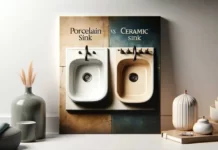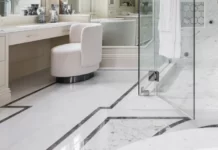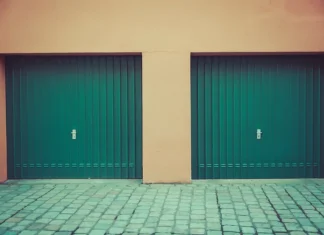Finally, I noticed the previous day that the toilet in our guest bathroom was not working properly and this is the reason why I don’t like using it- because the flush is very very slow. The toilet drain is slow and the swirling water helps the waste material go down.
It is very annoying to have a weak, swirling toilet that really takes forever prior to everything will even go down? Toilets that have slow flushes don’t take the waste along more often than not.
Many families in the US are not familiar that they spend almost 330$ more than they require to on their annual water bill and sewer. If you ensure that your plumbing systems and toilet work properly, then you can spend 500$ per year to 170$.
A properly running plumbing system starts with the identification of larger issues from smaller problems. Like, a slow draining toilet might not look like a big deal, right? No.
Toilets with no proper flushing system can indicate a larger problem that needs a lot of money.
If you can rectify the issue by yourself before it becomes a serious problem, you can spend a lot on plumbing expenses and your annual utility bill.
In this article, we will discuss everything that you need to know about how to fix a slow draining toilet.
How does a toilet work?
Surprisingly, the answer is simple- gravity. The construction of the toilet is based on the idea in mind: because of gravity water flows downward. Let’s talk in detail.
The tank located at the top of your toilet helps to store water. When you flush the tank, a plug opens which lets the water from the tank flow into the basin (toilet bowl) below. The water moves down further into the toilet drain, via S trap (that folds in the drain below your toilet), and at last out via your sewer mainline.
To conclude, your flushed toilet starts at its extreme point and continues to flow downhill till it gets to the sewer line of the city for processing eventually. This is gravity for you.
About 2,700 years ago, the first flush toilets were used. The modern versions we see today were invented by our namesake, Thomas Crapper.
What are the possible reasons you need to know why your toilet drains slowly?
Before we discuss the different ways to fix a slow flushing toilet, we should first look at the reasons. After getting an idea of what is triggering the problem, it should be much easier to figure out the solution.
The possible reasons are:
The lower level of water
In fact, this is the most common reason why toilets drain very slowly. For some reason, if the water present inside the tank is lower than the level recommended, then there will be less water to drain all the waste material which results in slow flushing or swirling.
The toilet tank requires enough water to gain its flushing power to drain down everything in the waste line. Check the float on your toilet. It could be due to the arm which is folded overly downwards. If the water level is not enough yet, the tendency is even, when the float rises a little, the fill valve automatically clicks the fill valve off.
- Mineral build-up under the toilet rim
Under your toilet rim, there are jet holes blocked with sediments or residues that gather over time as a result of repeated flushing.
This causes weak pressure of water that comes out of the holes. As time passes, more and more deposits of minerals will gather under your toilet rum if this problem is not solved. So, there are chances the pressure of water will get worse and become weak, thus resulting in slow flushing.
- Clogged drains – Blocked drains can be the reason for your toilet not being completely flush. You might think there must be some blockage in your waste lines or drains especially if there are kids. If not addressed promptly, this can be a serious problem.
Items like wipes, toys, floss, sanitary napkins, and other materials that are not big to fit inside and can block your clogged toilet drains. If immediately not solved, the item causing the blockage can go deeper down only the waste line and it will make the situation worse.
- Damaged toilet bowl – the inner system of a toilet bowl works via pressure. The colon must be airtight for pumping water out of the drain pipe. If the inner part of the colon is cracked or damaged somehow, then the pressure won’t be enough and will lead only to wall flushing.
This requires quick action as the interior colon of the flushing system is a bit complicated and must be fixed by the pros only. Probably this is not suggested for people who like to do DIY tasks as it may lead to bigger problems if you commit some mistake.
- Weak flushing system – over time, the flushing system in your toilet tank wears down. Due to mineral deposits and sediments, there is a possible build-up of moss that comes from hard water. This can be the main reason for the faulty flushing system as it will minimize the diameter of the pipe which can minimize the flow of water through the pathways.
- Defective/Old flapper – one of the main parts of the flushing system in your toilet tank is the flapper valve. It is meant to open up when the toilet is completely flushed to drain water out and shut down when water gets emptied in the tank.
But if the valve of the flapper doesn’t completely open, this will cause slow flushing. It might be the result of the rubber string or chain that is connected to the plunger attaching the flapper.
Because of wear and tear, the flapper valve can be loose or maybe it is too long that it does not pull the flapper to make sufficient opening for the water to drain completely. Thus, you have a toilet that flushes incompletely and slowly.
How to fix a slow flushing toilet – Different ways to Follow
There are some things you have to consider if you’re heart set on fixing the toilet by yourself. We suggest taking some time to refresh on the parts of a toilet.
But, if you are not sure about your repairing skills, then don’t feel ashamed about contacting an expert plumber.
1. Remove the damaged fill tube
The fill tube is not big enough but is a significant part of the inner portion of a toilet tank. Usually, the tube is black and made by using flexible rubber. It goes into a vertical wide tube called an overflow tube.
The fill tube is responsible for transmitting water from the tank to the bowl every time you flush. Over time, the fill tube gets deteriorated from normal wear and tear, during which it will unclip eventually.
When this occurs, the tank will fill with water which causes the valve to close. Water thus slowly fills the bowl. The problem can be fixed after inspection of the fill tube in your toilet tank.
If the tube is in good condition but is not connected, then it can attach simply with the back onto the cylinder. You will need replacement if the tube looks damaged.
2. Replace a cracked toilet bowl
As compared to damaged fill tubes, this problem is not common however, it can happen. A crack can sometimes occur inside the lower toilet bowl. The leak toilet bowl will lead to gradual dripping water out.
Unluckily, for a cracked toilet there is no easy fix.
The sealing agents applied will be temporary. Likely you will require to change the whole toilet and get a new one. Call your local plumber if you don’t feel comfortable installing a new toilet.
3. Dealing with a blocked sewer line vent
It is a pipe that moves out of the bathroom wall to the rooftop of a building or a house. The job of the pipe is the provision of fresh air that moves water via a drainage system.
The line also hinders harmful sewage gases from getting inside the home. This plumbing component is unfortunately susceptible to clogs.
You can deal and try with the sewer line vent yourself by getting permission to reach the roof. Look if any external thing is causing a blockage. Shine a flashlight down the pipe, if not.
If the blockage is not very far and you can get it, then a plumber’s snake can try to unclog it. Try to reach the help of a plumber, if you can’t manage to do it by yourself.
Significant tips for proper toilet care and maintenance
- Fix minor problems immediately
- Refrain from disposing of garbage
- Regular inspections
- Stop using toxic chemicals
Important signs to watch if you need to repair your toilet
The most important plumbing fixture in the home is perhaps your toilet. It is the main thing and no one can live without it. Modern life is much easier with toilets.
If there is some malfunctioning in the working of a toilet? How can you identify? Here are the noticeable signs.
- Toilet with a weak flush
- No water refilling
- Blocks more often
- Water is standing around the base
- Leakage of water out of the cracks
- Metal parts corrosion
- Constant running of the toilet
The Bottom Line
With the above-mentioned reasons and solutions, we hope you have got the answer of question that how to fix a slow flushing toilet. It is very inconvenient to have a slow flushing toilet, but if you have an idea of what you can do to resolve it in a few minutes. Proper care and maintenance is the key element to having a toilet with a long life. A regular inspection ensures to check the signs of loose screws and leaks. Regular cleaning of jet holes and toilet bowls can also enhance the flow of water.














